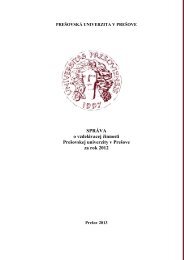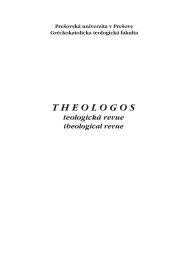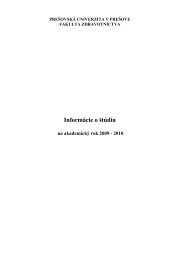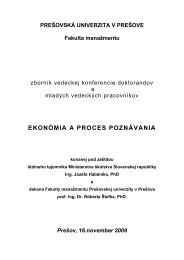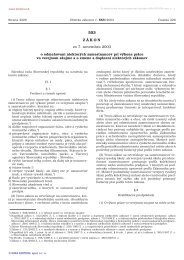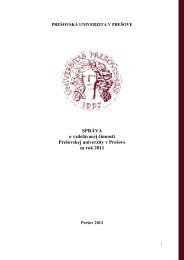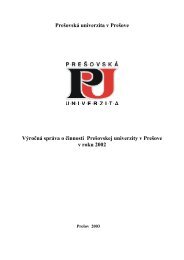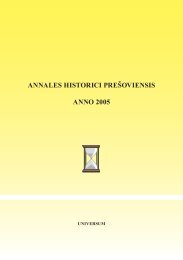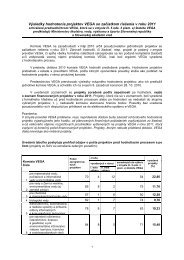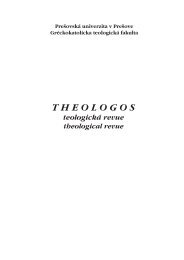Conceptualising the Post-communist Urban Transition
Conceptualising the Post-communist Urban Transition
Conceptualising the Post-communist Urban Transition
Create successful ePaper yourself
Turn your PDF publications into a flip-book with our unique Google optimized e-Paper software.
49(1) 43–60, January 2012<br />
Multiple Transformations:<br />
<strong>Conceptualising</strong> <strong>the</strong> <strong>Post</strong>-<strong>communist</strong><br />
<strong>Urban</strong> <strong>Transition</strong><br />
Luděk Sýkora and Stefan Bouzarovski<br />
[Paper first received, February 2009; in final form, November 2010]<br />
Abstract<br />
This paper develops a conceptual framework for interpreting <strong>the</strong> process of urban<br />
change in post-<strong>communist</strong> cities. The departure from <strong>the</strong> legacies of <strong>the</strong> <strong>communist</strong><br />
past has been effected through multiple transformation dynamics of institutional,<br />
social and urban change. While institutional reforms have been largely accomplished,<br />
<strong>the</strong> adjustment of urban land use patterns to new societal conditions is still ongoing.<br />
Hence, post-<strong>communist</strong> cities are still cities in transition. Using this interpretative<br />
framework and referring to a wide spectrum of academic work, <strong>the</strong> paper provides<br />
an overview of urban restructuring in post-<strong>communist</strong> countries over <strong>the</strong> past two<br />
decades with a specific focus on <strong>the</strong> examples of mutual integration of <strong>the</strong> three fields<br />
of transformation.<br />
Introduction<br />
Even though <strong>the</strong> past few years have seen<br />
<strong>the</strong> publication of a wide range of scholarly<br />
contributions to <strong>the</strong> field of post-<strong>communist</strong><br />
urban studies (see, for example, Hamilton<br />
et al., 2005; Tsenkova and Nedovic´-Budic´,<br />
2006; Borén and Gentile, 2007; Stanilov,<br />
2007), we would argue that <strong>the</strong>y too often<br />
focus on providing broad descriptions of<br />
urban transformation dynamics, ra<strong>the</strong>r than<br />
developing critical interpretive or explanatory<br />
frameworks. In this paper, we offer a more<br />
explicit grounding of <strong>the</strong> <strong>the</strong>orisation of<br />
urban change in post-<strong>communist</strong> cities.<br />
We argue that <strong>the</strong> post-<strong>communist</strong> city is<br />
an important object of study whose investigation<br />
brings new insights into urban studies.<br />
Hence, we first scrutinise <strong>the</strong> notion of <strong>the</strong><br />
post-<strong>communist</strong> city. We explicitly react to<br />
Luděk Sýkora is in <strong>the</strong> Department of Social Geography and Regional Development, Faculty of Science,<br />
Charles University, Albertov 6, Praha, 128 43, Czech Republic. E-mail: sykora@natur.cuni.cz.<br />
Stefan Bouzarovski is in <strong>the</strong> School of Geography, Earth and Environmental Sciences, University of<br />
Birmingham, Edgbaston, Birmingham, B15 2TT, UK. E-mail: s.bouzarovski@bham.ac.uk and <strong>the</strong><br />
Department of Social Geography and Regional Development, Faculty of Science, Charles University,<br />
Albertov 6, Praha, 128 43, Czech Republic.<br />
0042-0980 Print/1360-063X Online<br />
© 2011 <strong>Urban</strong> Studies Journal Limited<br />
DOI: 10.1177/0042098010397402
44 LUDĚK SÝKORA AND STEFAN BOUZAROVSKI<br />
debates where <strong>the</strong> continued ability of <strong>the</strong><br />
notion of ‘post-communism’ to offer a relevant<br />
framework for <strong>the</strong> analysis of various<br />
phenomena in former socialist countries is<br />
being put into question. Such thinking avoids<br />
post-communism, assuming that transition/<br />
transformation is already over and that cities<br />
should be approached from perspectives<br />
that dominate Western debates set within <strong>the</strong><br />
relatively stable environment of a globalising<br />
capitalist society (Tasan-Kok, 2004).<br />
In <strong>the</strong> main body of <strong>the</strong> paper, we develop<br />
a conceptual framework for interpreting <strong>the</strong><br />
process of urban change in post-<strong>communist</strong><br />
cities. We argue that <strong>the</strong> departure from <strong>the</strong><br />
legacies of <strong>the</strong> <strong>communist</strong> past has been<br />
effected through multiple transformation<br />
dynamics of institutional, social and urban<br />
transitions. These multiple transitions follow<br />
a specific temporal sequence. In general,<br />
<strong>the</strong>y move from addressing universal<br />
to more specific areas, from <strong>the</strong> political<br />
application of normative concepts to spontaneously<br />
unfolding social changes. In o<strong>the</strong>r<br />
words, urban transformations would not<br />
happen without transformations in <strong>the</strong> basic<br />
political and economic rules, which allowed<br />
for and stimulated economic and social<br />
restructuring that was in turn expressed in<br />
urban change.<br />
We argue that <strong>the</strong> nature of urban restructuring<br />
in post-<strong>communist</strong> countries has a<br />
common logic. By proposing a framework<br />
that suggests a layering and sequencing of<br />
institutional norms, social practices and<br />
urban spatial formations in <strong>the</strong> transformation<br />
of <strong>the</strong> post-<strong>communist</strong> city, we address<br />
<strong>the</strong> complex web of underlying relations and<br />
driving forces of urban change. We offer an<br />
overview of key <strong>the</strong>mes under each of <strong>the</strong><br />
levels of transformation with references<br />
to an extensive body of literature on post<strong>communist</strong><br />
urban change. The <strong>the</strong>oretical<br />
framework allows us to relate and integrate specific<br />
<strong>the</strong>mes and insights into <strong>the</strong> complex picture<br />
of post-<strong>communist</strong> urban restructuring.<br />
Current knowledge of post-<strong>communist</strong><br />
cities is highly uneven. Budapest, Prague and<br />
Warsaw have been over-represented in <strong>the</strong><br />
academic literature on post-socialist cities<br />
since <strong>the</strong> early 1990s, with Ljubljana, Tallinn,<br />
Moscow and Sofia joining <strong>the</strong>m in <strong>the</strong> 2000s.<br />
Cities such as St Petersburg and Kiev have only<br />
recently become objects of urban research<br />
(Popson and Ruble, 2000; Axenov et al., 2006;<br />
Borén, 2005). A few metropolitan areas serve<br />
as <strong>the</strong> major source of knowledge. They are<br />
not typical, but ra<strong>the</strong>r specific cases that usually<br />
represent <strong>the</strong> leading edge of social and<br />
urban change in <strong>the</strong>ir respective countries.<br />
Despite <strong>the</strong> unequal terrain of knowledge, we<br />
think that a focus on those cities and urban<br />
processes which are moving <strong>the</strong> frontier is justified<br />
by <strong>the</strong>ir key role in society, and because<br />
<strong>the</strong>y set examples of developments that are<br />
likely to impact o<strong>the</strong>r cities and regions.<br />
Theorising <strong>the</strong> <strong>Post</strong>-<strong>communist</strong><br />
City: Multiple Transformations<br />
Even though <strong>the</strong> series of deep-seated political<br />
and economic transformations in <strong>the</strong> former<br />
<strong>communist</strong> states of eastern and central<br />
Europe (ECE) is already two decades old, it<br />
is still difficult to describe urban areas in this<br />
part of <strong>the</strong> world with <strong>the</strong> aid of a stable set of<br />
attributes. Their defining feature remains <strong>the</strong><br />
incessant and relentless process of structural<br />
transformation that has started to unfold<br />
since <strong>the</strong> end of communism.<br />
<strong>Post</strong>-<strong>communist</strong> cities are cities under<br />
transformation. 1 <strong>Urban</strong> landscapes formed<br />
under socialism are being adapted and<br />
remodelled to new conditions shaped by <strong>the</strong><br />
political, economic and cultural transition<br />
to capitalism (Sýkora, 2009a). Cities in former<br />
<strong>communist</strong> countries can no longer be<br />
seen as socialist cities. Their development is<br />
now largely governed by market forces and<br />
democratically elected governments. Yet,<br />
<strong>the</strong>y are not fully developed capitalist cities<br />
ei<strong>the</strong>r. Looking at <strong>the</strong>ir morphology, land
THE POST-COMMUNIST URBAN TRANSITION 45<br />
use and social segregation, we can document<br />
typically capitalist city areas and districts,<br />
while sections of urban landscapes resemble<br />
frozen mirrors of socialism. The reorganisation<br />
of urban landscapes in post-<strong>communist</strong><br />
cities that began with <strong>the</strong> institutional reforms<br />
of <strong>the</strong> 1990s is far from complete.<br />
The post-<strong>communist</strong> transition is sometimes<br />
understood and interpreted as a set of<br />
institutional changes that were accomplished<br />
by national governments during <strong>the</strong> 1990s.<br />
Accepting this perspective, urban change in<br />
<strong>the</strong> countries whose governments have completed<br />
<strong>the</strong> prescribed institutional reforms<br />
can now be interpreted in a post-transition<br />
framework (see Leetmaa et al., 2009, about <strong>the</strong><br />
transitional 1990s and <strong>the</strong> post-transitional<br />
2000s) and hence we may speak about ‘cities<br />
after transition’ (<strong>the</strong> network of urban<br />
researchers on post-<strong>communist</strong> urban change<br />
bears a name CAT—Cities After <strong>Transition</strong>;<br />
http://citiesaftertransition.webnode.cz/).<br />
However, we consider this perspective to be<br />
narrow. We offer an alternative, more inclusive<br />
perspective on post-communism. For<br />
us, post-<strong>communist</strong> transition involves a<br />
much wider set of social and urban processes,<br />
including transformations in <strong>the</strong> urban spatial<br />
organisation of <strong>the</strong> built environment,<br />
land use and residential segregation.<br />
Although cities are now in a time-period that<br />
we can call ‘after-institutional-transition’, <strong>the</strong>y<br />
are also engulfed by a series of socioeconomic<br />
transformations, reflected in processes of<br />
urban change marked by <strong>the</strong> reconfiguration<br />
of <strong>the</strong> built environment, land use patterns and<br />
residential socio-spatial differentiation. Thus,<br />
while <strong>the</strong> classic transition understood as<br />
institutional transformation may be formally<br />
over, post-<strong>communist</strong> cities are still very much<br />
undergoing o<strong>the</strong>r post-<strong>communist</strong> transformations.<br />
For instance, we would argue that<br />
many of <strong>the</strong> contemporary land use changes<br />
in post-<strong>communist</strong> cities are outcomes of<br />
adjustments to new social conditions and can<br />
be interpreted as a part of <strong>the</strong> transition.<br />
The key aspect for understanding post<strong>communist</strong><br />
urban change is <strong>the</strong> distinction<br />
between: <strong>the</strong> short-term period, when <strong>the</strong> basic<br />
principles of political and economic organisation<br />
are changed; <strong>the</strong> medium-term period,<br />
when peoples’ behaviours, habits and cultural<br />
norms are adapted to a new environment<br />
and transformations in a number of spheres and<br />
begin to effect broader societal change; and<br />
<strong>the</strong> long-term period, in which more stable<br />
patterns of urban morphology, land use and<br />
residential segregation are reshaped. Hence,<br />
we argue that understanding and interpreting<br />
post-<strong>communist</strong> urban restructuring reflects<br />
<strong>the</strong> interactions between three aspects of<br />
post-<strong>communist</strong> transition: <strong>the</strong> institutional<br />
transformations that created a general societal<br />
framework for transition; transformations<br />
of <strong>the</strong> social, economic, cultural and political<br />
practices exhibited in <strong>the</strong> everyday life of<br />
people, firms and institutions and resulting in<br />
social restructuring; and, <strong>the</strong> transformation<br />
dynamics of urban change (Figure 1).<br />
Before proceeding to discuss <strong>the</strong> three<br />
dimensions of transition that form <strong>the</strong> core<br />
of our argument, we would like to revisit<br />
one of <strong>the</strong> key academic debates relevant to<br />
<strong>the</strong> region we are studying: <strong>the</strong> bi-decennial<br />
controversy between <strong>the</strong> concepts of transition<br />
and transformation. The term ‘transition’<br />
has mainly been associated with <strong>the</strong><br />
neo-liberal agenda of shock <strong>the</strong>rapy, based<br />
on <strong>the</strong> radical replacement of <strong>the</strong> basic political<br />
and economic institutions of socialism<br />
with democratic and market arrangements<br />
(Blanchard et al., 1994; Åslund, 2002, 2008).<br />
Conversely, <strong>the</strong> purpose of <strong>the</strong> concept of<br />
‘transformation’ has been to accentuate <strong>the</strong><br />
continuity and path-dependence of post<strong>communist</strong><br />
developments, while highlighting<br />
<strong>the</strong> hybrid nature of post-<strong>communist</strong> realities<br />
with respect to <strong>the</strong> recombination of socialist<br />
and capitalist elements as constituents of <strong>the</strong><br />
new post-<strong>communist</strong> society (Nielsen et al.,<br />
1995; Stark, 1992, 1996; Pickles and Smith,<br />
1998; Smith and Swain, 1998; Pavlínek, 2003).
46 LUDĚK SÝKORA AND STEFAN BOUZAROVSKI<br />
<strong>Transition</strong> I: Institutional transformations<br />
democratic government elections,<br />
privatization, price liberalization, foreign trade<br />
liberalization<br />
<strong>Transition</strong> II: Social transformations<br />
internationalisation, economic restructuring,<br />
social polarization, postmodern culture, neoliberal<br />
politics<br />
<strong>Transition</strong> III: <strong>Urban</strong><br />
transformations<br />
city centre commercialization,<br />
inner city regeneration, outer city<br />
suburbanization<br />
Figure 1. Multiple transformations.<br />
We offer a more inclusive approach that<br />
accommodates <strong>the</strong> two opposed perspectives<br />
on this issue. We use <strong>the</strong> term ‘transition’<br />
to accentuate <strong>the</strong> general departure from<br />
communism towards societies that more<br />
or less embrace <strong>the</strong> market and democratic<br />
principles. We reserve <strong>the</strong> concept of ‘transformation’<br />
to connote <strong>the</strong> great number of<br />
particular institutional, social and urban<br />
reconfigurations. We understand <strong>the</strong> postsocialist<br />
transition as a broad, complex and<br />
lengthy process of social change (Herrschel,<br />
2007), which proceeds through a multitude<br />
of particular transformations (Sýkora, 2008).<br />
<strong>Transition</strong> I: Institutional<br />
Reconfigurations<br />
The onset of post-communism was marked<br />
by <strong>the</strong> ousting of <strong>the</strong> <strong>communist</strong> party<br />
regime and central planning, with <strong>the</strong><br />
general aim of creating a democratic political<br />
system and a market economy. In many<br />
post-<strong>communist</strong> countries, basic reforms<br />
of <strong>the</strong> political system were achieved in <strong>the</strong><br />
first months after <strong>the</strong> collapse of communism.<br />
The first democratic elections at <strong>the</strong><br />
national level were followed by democratic<br />
elections at <strong>the</strong> local level and <strong>the</strong> decentralisation<br />
of power to local governments<br />
(Enyedi, 1998; Bunce, 1999; Tosics, 2005a).<br />
Newly established democratic governments<br />
focused on <strong>the</strong> reduction of direct<br />
state intervention, <strong>the</strong> privatisation of state<br />
assets, <strong>the</strong> liberalisation of prices and <strong>the</strong><br />
establishment of free trade relations with an<br />
aim to develop <strong>the</strong> private sector, stimulate<br />
<strong>the</strong> development of markets and reorient<br />
trade towards <strong>the</strong> international economy<br />
(EBRD 1999).<br />
Later, <strong>the</strong> concepts and practices of transition<br />
were widened from <strong>the</strong> initial imperative of<br />
minimising <strong>the</strong> state towards redefining <strong>the</strong><br />
state in <strong>the</strong> sense of “improving <strong>the</strong> quality
THE POST-COMMUNIST URBAN TRANSITION 47<br />
of state and private institutions and ensuring<br />
that <strong>the</strong>y work well toge<strong>the</strong>r” (EBRD, 2009,<br />
p. 96). It became recognised that, in order to<br />
function properly, <strong>the</strong> private sector needs<br />
market-supporting public institutions and<br />
policies that include<br />
a functioning legal system to enforce<br />
contractual obligations; regulation to deal<br />
with external effects and incentive problems;<br />
safety nets to allay concerns about social<br />
cohesion; physical and intellectual property<br />
rights protection; and competition policy<br />
(EBRD, 2009, p. 96).<br />
In <strong>the</strong>ir entirety, <strong>the</strong> rejection of communism<br />
and <strong>the</strong> acceptance of capitalist<br />
features have placed <strong>the</strong> post-<strong>communist</strong><br />
institutional transition on a somewhat similar<br />
trajectory. However, despite <strong>the</strong>ir main<br />
shared direction—a democratic political<br />
system and a market economy—institutional<br />
market reforms have not been uniform. Major<br />
differences have emerged between <strong>the</strong><br />
countries that have managed to apply more<br />
comprehensively <strong>the</strong> Western concept of capitalism,<br />
and those whose development is more<br />
based on <strong>the</strong> locally specific recombinations<br />
of selected aspects of socialism, capitalism<br />
and unique features that have emerged during<br />
post-communism. Fur<strong>the</strong>rmore, even <strong>the</strong><br />
quick and effective transformers have differed<br />
in <strong>the</strong> concrete application of reforms. Even<br />
though transforming societies, countries and<br />
cities do not share <strong>the</strong> same post-<strong>communist</strong><br />
development paths, as <strong>the</strong>y are moving in<br />
a similar direction away from communism<br />
(see Figure 2).<br />
The main outcomes of institutional transformations,<br />
which<br />
influenced urban development were 1) new<br />
societal rules established on democratic<br />
policy and (free) market principles; 2) a vast<br />
number of private actors operating in <strong>the</strong> city<br />
(including property owners); 3) an openness<br />
of local economic systems to international<br />
economic forces (Sýkora. 1999a, p. 81).<br />
Politics<br />
democratic<br />
institutions<br />
country a<br />
country b<br />
post-<strong>communist</strong><br />
countries 2010<br />
central planning<br />
institutions<br />
country c<br />
transition<br />
country n<br />
market<br />
institutions<br />
Economy<br />
<strong>communist</strong><br />
countries 1988<br />
totalitarian<br />
institutions<br />
Figure 2. Institutional transformations: multiple country trajectories.
48 LUDĚK SÝKORA AND STEFAN BOUZAROVSKI<br />
Some institutional transformations—<br />
especially <strong>the</strong> privatisation of state-owned<br />
assets, including housing—have exerted<br />
important impacts on <strong>the</strong> development<br />
of cities and <strong>the</strong>ir neighbourhoods and<br />
urban zones (Sýkora and Šimoníčková, 1994;<br />
Eskinasi, 1995; Häussermann, 1996; Bodnár,<br />
2001; Korhonen, 2001; Kährik, 2000, 2002;<br />
Kährik et al., 2003; Dawidson, 2004). For<br />
instance, massive privatisation of housing<br />
leading to <strong>the</strong> dominance of owner-occupation<br />
(Brade et al., 2009) strongly determined <strong>the</strong><br />
mobility of population, as well as possibilities<br />
for co-ordinated urban regeneration.<br />
Space does not permit a comprehensive<br />
account of <strong>the</strong> impact of institutional transformation<br />
on particular urban locales. Aside<br />
from <strong>the</strong> explanation of a myriad of various<br />
government-managed transformation processes,<br />
we would also have to acknowledge<br />
differences in <strong>the</strong> nature of institutional transformations<br />
among countries. For illustration<br />
purposes, we use <strong>the</strong> example of <strong>the</strong> use or<br />
refusal of restitution (<strong>the</strong> return of nationalised<br />
properties to <strong>the</strong>ir previous owners<br />
or <strong>the</strong>ir descendants) in selected countries,<br />
which has created strikingly different conditions<br />
within urban property markets.<br />
While Czechia, Estonia and Germany chose<br />
to return properties to <strong>the</strong>ir pre-socialist<br />
owners, Hungary and Romania did not follow<br />
this path (Eskinasi, 1995; Häussermann,<br />
1996; Bodnár, 2001; Kährik, 2000, 2002;<br />
Kährik et al., 2003; Dawidson, 2004). In<br />
<strong>the</strong> former two states, restituted properties<br />
created a favourable context for <strong>the</strong> development<br />
of property markets in attractive<br />
urban neighbourhoods and <strong>the</strong> suburban<br />
ring. The supply of restituted real estate<br />
has been a decisive condition for <strong>the</strong> rapid<br />
commercialisation of <strong>the</strong> central city, <strong>the</strong><br />
gentrification of some inner-city areas and<br />
<strong>the</strong> suburban ‘explosion’ of former rural hinterlands.<br />
While apartment buildings in <strong>the</strong><br />
inner city of Prague were not only privatised,<br />
but remained in single ownership thanks<br />
to this method of privatisation, inner-city<br />
housing privatisation in Budapest has been<br />
characterised by <strong>the</strong> sales of individual flats<br />
and <strong>the</strong> consequent fragmentation of ownership<br />
within single buildings.<br />
Restitution in Prague and Tallinn provided<br />
a significant supply of real estate for<br />
inner-city property markets, leading to<br />
dramatic land use changes in attractive locations.<br />
Commercialisation and gentrification<br />
quickly followed thanks to <strong>the</strong> supply of<br />
restituted properties in <strong>the</strong> form of a building<br />
as a single property. This was in contrast with<br />
Budapest, where restitution was not applied.<br />
The ownership fragmentation within single<br />
buildings in Budapest prevented <strong>the</strong> quick<br />
restoration of properties, while slowing<br />
down population change and gentrification<br />
(Sýkora, 2005). Without judging which of<br />
<strong>the</strong>se outcomes has been better for <strong>the</strong> city<br />
and its inhabitants, <strong>the</strong> example of restitution<br />
demonstrates that <strong>the</strong> application of different<br />
strategies in <strong>the</strong> course of governmentmanaged<br />
institutional transformations had<br />
different implications for subsequent urban<br />
and neighbourhood change.<br />
<strong>Transition</strong> II: Social Practices and<br />
Organisation<br />
The outcomes of <strong>the</strong> institutional<br />
transformations—particularly <strong>the</strong> market<br />
rules of resource allocation, <strong>the</strong> vast number of<br />
new private owners, entrepreneurs and firms,<br />
and <strong>the</strong> openness of local economic systems<br />
to an international economy—have formed<br />
<strong>the</strong> basic conditions for <strong>the</strong> spontaneous<br />
emergence of a series of economic, social and<br />
cultural transformations. This ‘second’ transition<br />
in <strong>the</strong> domain of social organisation and<br />
practice has heavily influenced urban change<br />
through <strong>the</strong> dynamics of internationalisation<br />
and globalisation, economic-restructuringinduced<br />
deindustrialisation, <strong>the</strong> growth of<br />
producer services, increasing social differentiation,<br />
new modes of post-modern culture and
THE POST-COMMUNIST URBAN TRANSITION 49<br />
neo-liberal political practices (Sýkora, 1994,<br />
2009a; Buzar, 2008). Although such processes<br />
operate in all post-<strong>communist</strong> countries,<br />
<strong>the</strong>ir intensity and character are modified by<br />
specific local conditions. In <strong>the</strong> paragraphs<br />
that follow, we discuss <strong>the</strong>se contingencies in<br />
fur<strong>the</strong>r detail.<br />
Transnational companies and foreign direct<br />
investment started to play a decisive role in<br />
reshaping local economies and geographies,<br />
as well as determining <strong>the</strong> position of postsocialist<br />
countries, regions and cities in <strong>the</strong><br />
global economic order (Turnock, 1997;<br />
Parysek, 2004; Hamilton and Carter, 2005;<br />
Tsenkova, 2008). In major cities, internationalisation<br />
was strongly present in producer<br />
services that formed <strong>the</strong> soft infrastructure<br />
for <strong>the</strong> capitalist system’s expansion to new<br />
markets, and later in consumer services<br />
and industrial production. Foreign managers<br />
and high-salary employees of foreign<br />
companies formed a specific segment of <strong>the</strong><br />
demand in <strong>the</strong> high-income housing market<br />
(Badyina and Golubchikov, 2005; Medvedkov<br />
and Medvedkov, 2007; Sýkora, 2005). By<br />
contrast, labour immigrants constituted <strong>the</strong><br />
bottom tier of <strong>the</strong> socioeconomic hierarchy<br />
in some countries (Drbohlav and Dzúrová,<br />
2007) leading to <strong>the</strong> formation of new<br />
ethnic enclaves. Foreign investment in real<br />
estate—office, retail and industrial, as well as<br />
residential space—began to change <strong>the</strong> face<br />
of urban landscapes and skylines (Adair et al.,<br />
1999; Tasan-Kok, 2004; Stanilov, 2007; Sýkora,<br />
1998, 2007a). The highly uneven balance<br />
between Western and domestic actors—<strong>the</strong><br />
former possessing a larger capital stock and<br />
access to a more extensive pool of resources<br />
(Ghanbari-Parsa and Moatazed-Keivani, 1999;<br />
McGreal et al., 2002)—was fur<strong>the</strong>r increased<br />
by <strong>the</strong> policies and measures favouring foreign<br />
enterprises with a strong capital base.<br />
Considering that <strong>the</strong> economic restructuring<br />
processes involved deindustrialisation and<br />
tertiarisation (Kavetskyy and Ostaphiychuk,<br />
2005; Tosics, 2005b), post-<strong>communist</strong><br />
economic development has been marked<br />
by both economic decline and growth. City<br />
economies were integrated into <strong>the</strong> global<br />
economy in a highly uneven manner. Capital<br />
cities ranked well thanks to <strong>the</strong>ir role as<br />
national command-and-control centres and<br />
gateways into national economies. Successful<br />
medium-sized regional centres provided<br />
cheaper and well-skilled labour for routine<br />
production within <strong>the</strong> global assembly line.<br />
At <strong>the</strong> same time, peripheries were left with<br />
a mixture of hope and depression.<br />
<strong>Urban</strong> economic decline was closely related<br />
to <strong>the</strong> closure of industrial enterprises and<br />
affected virtually all post-<strong>communist</strong> cities.<br />
The growth of economic activities was concentrated<br />
in <strong>the</strong> service sector. The development<br />
of consumer services, particularly retail,<br />
affected most cities (Nagy, 2001). However, it<br />
offered low paid-jobs and has not brought any<br />
substantial streng<strong>the</strong>ning of <strong>the</strong> urban economic<br />
base. For urban development, <strong>the</strong> most<br />
important was growth in advance producer<br />
services. However, it provided benefits only<br />
for major command-and-control centres,<br />
usually capital cities (Gritsai, 1997a; 1997b).<br />
This left <strong>the</strong> remaining urban areas struggling<br />
for foreign direct investment in manufacturing<br />
that would bring reindustrialisation and<br />
jobs for <strong>the</strong> local population.<br />
Economic restructuring had profound effects<br />
on urban landscapes. Deindustrialisation left<br />
extensive brownfields behind it, posing both<br />
a potential for redevelopment as well as a<br />
threat of fur<strong>the</strong>r decay (Misztal, 1997; Kiss,<br />
1999, 2004; Bárta et al., 2006; Sýkorová, 2007).<br />
Producer services concentrated on expanding<br />
<strong>the</strong> city cores of major centres, while contributing<br />
to <strong>the</strong>ir rapid commercialisation<br />
(Lisowski and Wilk, 2002; Stanilov, 2007;<br />
Sýkora, 1999a). Many of <strong>the</strong>se activities later<br />
decentralised to out-of-centre locations and<br />
business parks at <strong>the</strong> city outskirts (Sýkora,<br />
2007a). Retail and tourist facilities in attractive<br />
places brought new consumption landscapes<br />
to core cities (Cooper and Morpeth,
50 LUDĚK SÝKORA AND STEFAN BOUZAROVSKI<br />
1998; Hoffman and Musil, 1999), followed<br />
by <strong>the</strong> subsequent expansion of shopping in<br />
suburban areas (Pommois, 2004; Rebernik<br />
and Jakovčić, 2006; Sić, 2007).<br />
Economic change also induced growing<br />
wage and income disparities (Sýkora,<br />
1999b; Węcławowicz, 2002; Szirmai, 2007).<br />
Although national social security systems<br />
mitigated some of <strong>the</strong> social hardship stemming<br />
from economic restructuring, <strong>the</strong>y<br />
could not change <strong>the</strong> generally accepted move<br />
towards higher income differentiation that<br />
contributed to <strong>the</strong> rise of social polarisation<br />
among households and <strong>the</strong> formation of<br />
new territorial disparities in <strong>the</strong> geographies<br />
of inequality (Węcławowicz, 2004). Income<br />
disparities were reflected in <strong>the</strong> re-emergence<br />
of pre-socialist patterns of residential differentiation,<br />
<strong>the</strong> establishment of new enclaves<br />
of affluence and <strong>the</strong> emergence of segregated<br />
districts of social exclusion (Kovács, 1998;<br />
Kowalski and Śleszyn´ski, 2006; Ladányi,<br />
2002; Szczepanski and Slezak-Tazbir, 2008;<br />
Węcławowicz 2005; Polanska, 2008). The<br />
rapidly growing international migration<br />
brought an emerging ethnic dimension<br />
to residential segregation (Sýkora, 2009b)<br />
within societies that were originally usually<br />
ethnically homogeneous.<br />
Social and physical upgrading developed<br />
via <strong>the</strong> incumbent upgrading and gentrification<br />
of existing neighbourhoods (Standl and<br />
Krupickaité, 2004; Badyina and Golubchikov,<br />
2005; Sýkora, 2005; Chelcea, 2006), <strong>the</strong> construction<br />
of new apartment blocks in innercity<br />
areas (Medvedkov and Medvedkov, 2007)<br />
and <strong>the</strong> growth of new suburban communities<br />
of family housing for <strong>the</strong> ‘new rich’ and,<br />
increasingly, <strong>the</strong> middle classes. In some postsocialist<br />
cities, <strong>the</strong> escape to rural suburban<br />
areas presented a survival strategy for <strong>the</strong> lowincome<br />
population (Ladányi, 1997; Ladányi<br />
and Szelényi, 1998; Leetmaa and Tammaru,<br />
2007), which o<strong>the</strong>rwise would remain trapped<br />
in decaying inner-city neighbourhoods and<br />
less desirable post-war housing estates.<br />
The new conditions allowed for <strong>the</strong><br />
development of a greater plurality of values, as<br />
well as a tendency towards individualism and<br />
<strong>the</strong> promotion of self-interest. The values and<br />
preferences of a younger generation shaped<br />
by new opportunities—in addition to <strong>the</strong><br />
social deprivation brought about by economic<br />
reforms—resulted in <strong>the</strong> rapid decline of family<br />
formation (Lesthaeghe and Surkyn, 2002;<br />
Frejka, 2008; Sobotka, 2008). The acceleration<br />
of <strong>the</strong> ‘second demographic transition’ has<br />
impacted residential choices, with consequences<br />
for urban housing (Steinführer and<br />
Haase, 2007). More importantly, consumption<br />
has become <strong>the</strong> key life target for large<br />
parts of <strong>the</strong> population. Globalisation has<br />
brought a homogenisation of consumption<br />
via <strong>the</strong> same goods offered by transnational<br />
corporations. Yet not everyone can enjoy <strong>the</strong>se<br />
opportunities equally: consumption is limited<br />
by income levels and preferences shaped by<br />
custom-made advertising. Shopping centres<br />
use visual features and various forms of entertainment<br />
to attract consumers, while transnational<br />
corporations highlight <strong>the</strong>ir presence<br />
in <strong>the</strong> urban structure (Hirt, 2008a). Private<br />
firms use cultural strategies to sell <strong>the</strong>mselves,<br />
while streng<strong>the</strong>ning <strong>the</strong>ir influence and competitiveness<br />
as well as demonstrating <strong>the</strong>ir<br />
pride and power. The post-modern aes<strong>the</strong>tic<br />
in <strong>the</strong> post-socialist city has intensified <strong>the</strong><br />
collage of <strong>the</strong> past and present, local and<br />
global, standard and specific, real and virtual.<br />
The socialist propaganda of collective<br />
will has been replaced by individual choice<br />
in a consumption-orientated capitalist city<br />
(Czepczyński, 2008).<br />
Even though real pragmatic politics has<br />
mixed neo-liberal ideology with attempts<br />
to keep social peace via <strong>the</strong> retention of at<br />
least some socialist regulation, national and<br />
urban governments have generally pursued<br />
political strategies influenced by neo-liberal<br />
political discourses (Govan, 1995). The<br />
decisions of both central governments and<br />
local politicians have been grounded in a
THE POST-COMMUNIST URBAN TRANSITION 51<br />
neo-liberal ideology, which sees <strong>the</strong> free,<br />
unregulated market as <strong>the</strong> only resource allocation<br />
mechanism that can generate a wealthy,<br />
economically efficient and socially just society.<br />
Politicians have perceived <strong>the</strong> state as<br />
<strong>the</strong> root of all evil in society, and <strong>the</strong> main<br />
enemy of <strong>the</strong> economy in particular. <strong>Urban</strong><br />
planning has also been seen as contradictory<br />
to <strong>the</strong> market. Clientelism has prevailed<br />
and ad hoc decisions have been preferred<br />
over <strong>the</strong> creation of policies embedded in a<br />
long-term plan, strategy or vision of urban<br />
development (Sýkora, 2006; Horak, 2007).<br />
Internal urban transformations have often<br />
been left to <strong>the</strong> operation of <strong>the</strong> free market,<br />
still partially bound within <strong>the</strong> framework<br />
of traditional rigid physical planning instruments.<br />
However, after <strong>the</strong> first decade of<br />
transition, many urban governments learned<br />
new techniques of urban management and<br />
governance. They started to apply more<br />
sophisticated tools, such as strategic planning<br />
(Maier, 2000; Dimitrovska-Andrews,<br />
2005; Pichler-Milanović, 2005; Ruoppilla,<br />
2007). The application of European Union<br />
programming documents in <strong>the</strong> accession<br />
process has fur<strong>the</strong>r helped to consolidate<br />
urban government measures towards more<br />
co-ordinated and complex policies to tackle<br />
urban problems (van Kempen et al., 2005;<br />
Altrock et al., 2006). The power of <strong>the</strong> planner<br />
who governed <strong>the</strong> allocation of investments<br />
in <strong>the</strong> socialist city has been supplanted by<br />
investors who steer politicians and planners<br />
in a direction favourable to capital.<br />
<strong>Transition</strong> III: Reconfiguring <strong>the</strong><br />
<strong>Urban</strong> Landscape<br />
The urban environments of post-<strong>communist</strong><br />
cities are being adapted and reconfigured<br />
to <strong>the</strong> new conditions created by a myriad<br />
of political, economic, social and cultural<br />
transformations. The reorganisation of<br />
post-<strong>communist</strong> urban spaces involves <strong>the</strong><br />
restructuring of existing urban areas and <strong>the</strong><br />
formation of new post-<strong>communist</strong> urban<br />
landscapes leading to qualitatively new urban<br />
formats. The fact that inherited socialist<br />
urban features are often in conflict with <strong>the</strong><br />
principles of <strong>the</strong> capitalist urban economy is<br />
reflected in <strong>the</strong> reshaping of existing urban<br />
structures, including <strong>the</strong> re-emergence of<br />
pre-<strong>communist</strong> patterns in countries that<br />
had an earlier experience of capitalism. The<br />
new conditions also stimulate <strong>the</strong> creation<br />
of new post-<strong>communist</strong> urban landscapes,<br />
which become symbolic manifestations of<br />
<strong>the</strong> future city.<br />
The most visible effects of restructuring<br />
are typically concentrated in <strong>the</strong> attractive<br />
parts of <strong>the</strong> city centre, in addition to selected<br />
inner-city nodes and zones, as well as numerous<br />
suburban locations (Sailer-Fliege, 1999;<br />
Sýkora 1999a; Haase and Steinführer, 2005;<br />
Hirt, 2006). This is because <strong>the</strong> main transformations<br />
in <strong>the</strong> spatial pattern of former<br />
socialist cities and <strong>the</strong>ir metropolitan areas<br />
have included <strong>the</strong> commercialisation and<br />
expansion of urban cores (Sýkora et al., 2000;<br />
Parysek and Mierzejewska, 2006; Sić, 2007),<br />
<strong>the</strong> dynamic revitalisation of some sections<br />
of <strong>the</strong> inner city (Sýkora, 2005; Temelová,<br />
2007) and <strong>the</strong> radical transformation of outer<br />
cities and <strong>the</strong> urban hinterland through suburbanisation<br />
(Kok and Kovács, 1999; Timár<br />
and Váradi, 2001; Lisowski, 2004; Kontuly and<br />
Tammaru, 2006; Hirt, 2007, 2008b; Tammaru<br />
and Leetmaa, 2007; Leetmaa and Tammaru,<br />
2007; Novák and Sýkora, 2007; Kährik and<br />
Tammaru, 2008). Still, large parts of <strong>the</strong> inner<br />
city maintain a relatively modest pace of<br />
transformation (Steinführer, 2006; Steinführer<br />
and Haase, 2007).<br />
We can also witness a temporal dimension<br />
in <strong>the</strong> change of central cities and suburbs.<br />
The first decade of transition in <strong>the</strong> 1990s was<br />
characterised by an investment inflow into<br />
city centres, especially in <strong>the</strong> early reforming<br />
countries, triggering a decline in <strong>the</strong>ir residential<br />
function amidst substantial commercialisation<br />
and physical upgrading. This was
52 LUDĚK SÝKORA AND STEFAN BOUZAROVSKI<br />
followed by a process of decentralisation, as<br />
investment flowed to both out-of-centre and<br />
suburban locations (Sýkora, 2007a; Sýkora<br />
and Ouředníček, 2007). Central and inner-city<br />
urban restructuring involved <strong>the</strong> replacement<br />
of existing activities (primarily industry)<br />
with new and economically more efficient<br />
uses, taking <strong>the</strong> form of commercialisation<br />
(Sýkora, 1999a; Hirt, 2008a), gentrification<br />
(Badyina and Golubchikov, 2005; Feldman,<br />
2000a; Standl and Krupickaité, 2004; Sýkora,<br />
2005), <strong>the</strong> construction of new apartments<br />
(Medvedkov and Medvedkov, 2007), brownfield<br />
regeneration (Feldman, 2000b; Kiss,<br />
2004), <strong>the</strong> establishment of new secondary<br />
commercial centres (Temelová, 2007) and<br />
out-of-centre office clusters (Sýkora, 2007a).<br />
In <strong>the</strong> course of time, as <strong>the</strong> personal wealth<br />
of <strong>the</strong> population increased and mortgages<br />
became available, suburbanisation became<br />
<strong>the</strong> most dynamic process affecting <strong>the</strong> metropolitan<br />
landscapes of post-<strong>communist</strong> cities.<br />
Residents with different social statuses moved<br />
to <strong>the</strong> suburban areas in <strong>the</strong> 1990s, because<br />
of coping problems in <strong>the</strong> major cities and/<br />
or unfulfilled housing aspirations (Ladányi<br />
and Szelényi, 1998; Tammaru and Leetmaa,<br />
2007). The 2000s were marked by an intensifying<br />
flow of wealthier populations into <strong>the</strong><br />
suburbs. One of <strong>the</strong> largest controversies in<br />
post-<strong>communist</strong> urban change is thus linked<br />
to <strong>the</strong> process of suburbanisation, which is<br />
being praised for introducing housing choice<br />
under free market conditions on <strong>the</strong> one<br />
hand, while being blamed for social, economic<br />
and environmental non-sustainability on <strong>the</strong><br />
o<strong>the</strong>r (mainly due to <strong>the</strong> dramatic increase in<br />
daily commuting; see Garb and Dybicz, 2006;<br />
Tammaru, 2005). In any case, <strong>the</strong> compact<br />
physical morphology of <strong>the</strong> former socialist<br />
city is being rapidly transformed under <strong>the</strong><br />
parallel influence of residential and commercial<br />
activities sprawling into <strong>the</strong> hinterland<br />
(Nuissl and Rink, 2005; Ouředníček, 2007;<br />
Matlovič and Sedláková, 2007; Sýkora and<br />
Ouředníček, 2007; Tammaru et al., 2009).<br />
Yet such controversies are also evident<br />
in city centres, where commercialisation<br />
has been accompanied by increasing traffic<br />
congestion and has come into conflict with<br />
historical heritage (Pucher, 1999; Sýkora,<br />
1999a; Hirt and Kovachev, 2006; Kotus, 2006;<br />
Bouzarovski, 2010). The visual value of citycentre<br />
landscapes has been appropriated by<br />
<strong>the</strong> growth of business service enterprises<br />
that clearly demonstrate <strong>the</strong> strong presence<br />
of international private capital (Czepczyński,<br />
2008). The socially and spatially selective gentrification<br />
dynamic that is partly associated<br />
with foreign business élites has proceeded<br />
without challenge, since it has been seen by<br />
local politicians as well as <strong>the</strong> local population<br />
as a natural process that brings bourgeois<br />
neighbourhoods ‘back to <strong>the</strong>ir former glory’<br />
(Sýkora, 2005). Thus, revitalisation—whe<strong>the</strong>r<br />
based on residential or non-residential<br />
functions—is now directed by capital ra<strong>the</strong>r<br />
than governments. It has brought investment<br />
to some decaying areas, leaving many o<strong>the</strong>rs<br />
unattended (Misztal, 1997; Bárta et al.,<br />
2006; Bouzarovski, 2009). The emergence<br />
of brownfields and <strong>the</strong> physical and social<br />
decline of some housing estates constructed<br />
during socialism thus present major problems<br />
in <strong>the</strong> post-socialist city (Maier, 1997, 2005).<br />
Property development brings densification<br />
to central-city landscapes, while brownfields<br />
formed by deindustrialisation present new<br />
inner-city spaces of opportunity, whose former<br />
structure can be completely remodelled,<br />
provided <strong>the</strong>re is sufficient investor interest.<br />
City centres are gaining <strong>the</strong> spirit of business<br />
and—in some instances—tourist districts<br />
(Hoffman and Musil, 1999; Simpson, 1999),<br />
keeping <strong>the</strong> presence of government and some<br />
cultural functions. Tertiarisation has also<br />
brought <strong>the</strong> fortune of growth to outer areas,<br />
forming secondary nodes of employment in<br />
high-earning services concentrated in office<br />
districts (Sýkora, 2007a). These are located<br />
alongside new landscapes of consumption<br />
in shopping and entertainment complexes
THE POST-COMMUNIST URBAN TRANSITION 53<br />
that offer mass amenities for <strong>the</strong> entire<br />
population, in addition to low-paid jobs to<br />
<strong>the</strong> less-skilled and mostly female part of<br />
<strong>the</strong> workforce. High concentrations of retail<br />
facilities are being strategically placed in new<br />
nodes between existing residential areas with<br />
<strong>the</strong>ir original small neighbourhood centres<br />
and <strong>the</strong> compact city of mass consumption<br />
power and booming wealthy suburbs. The<br />
original hierarchically organised system of<br />
services with a dominant central city is transformed<br />
via layers of new centres into a more<br />
polycentric structure.<br />
The socio-spatial patterns of <strong>the</strong> post<strong>communist</strong><br />
city are also changing. The<br />
streng<strong>the</strong>ning of existing disparities among<br />
parts of cities is counterbalanced by <strong>the</strong><br />
social recomposition of gentrified districts,<br />
declining housing estates and <strong>the</strong><br />
suburbanisation of better-off parts of <strong>the</strong><br />
population. Surprisingly, socio-spatial disparities<br />
between different urban districts<br />
have not necessarily increased during <strong>the</strong><br />
first decades of capitalism (Gentile and<br />
Tammaru, 2006); ra<strong>the</strong>r, one finds pockets<br />
of wealth and poverty at more local<br />
spatial scales (Ruoppila and Kährik, 2003;<br />
Ruoppila, 2005; Marcińczak and Sagan, 2010;<br />
Bouzarovski et al., 2011). This trend has<br />
been explained by <strong>the</strong> fact that segregation<br />
processes were initially dampened by socialist<br />
legacies, bringing urban districts with a<br />
higher or lower social status (such as housing<br />
estates and <strong>the</strong> rural hinterland respectively)<br />
closer to <strong>the</strong> city average (Sýkora, 2007b).<br />
However, <strong>the</strong> new capitalist principles have<br />
moved such cities towards outcomes that<br />
will imprint <strong>the</strong>mselves more powerfully on<br />
post-<strong>communist</strong> urban spaces in <strong>the</strong> course<br />
of time. This is being gradually signalled by<br />
<strong>the</strong> contrasting pictures provided by ghettoising<br />
areas and gated communities, as<br />
examples of extreme developments in segregation<br />
patterns (Kovács, 1998; Blinnikov<br />
et al., 2006; Stoyanov and Frantz, 2006;<br />
Brabec and Sýkora, 2009; Brade et al., 2009).<br />
Conclusions<br />
The core argument of our paper is that post<strong>communist</strong><br />
cities are subject to three aspects<br />
of post-<strong>communist</strong> transition: institutional<br />
transformations; transformations of social<br />
practices; and, transformations in urban<br />
space. While <strong>the</strong> formal remodelling of <strong>the</strong><br />
institutional landscape has now been largely<br />
completed in many former <strong>communist</strong><br />
countries, social practices and structures still<br />
retain some socialist features and large parts<br />
of post-<strong>communist</strong> cities exhibit a typically<br />
socialist urban character. Therefore, we have<br />
argued that post-<strong>communist</strong> cities are still<br />
cities in transition (Sýkora, 2000). Moving<br />
beyond <strong>the</strong> association of transition only with<br />
government-managed reforms, we have provided<br />
a fuller account of post-communism.<br />
This wider perspective on <strong>the</strong> post-<strong>communist</strong><br />
transition still offers a relevant framework<br />
for <strong>the</strong> analysis of social and urban change in<br />
former socialist countries.<br />
We have also addressed <strong>the</strong> relationship<br />
between post-<strong>communist</strong> urban restructuring,<br />
on <strong>the</strong> one hand, and <strong>the</strong> notions of<br />
transition and transformation on <strong>the</strong> o<strong>the</strong>r.<br />
We have distinguished between general trajectories<br />
of social and urban changes and<br />
particular mechanisms through which <strong>the</strong>y<br />
are realised. <strong>Urban</strong> transition consists of<br />
transformations in land use or socio-spatial<br />
patterns affected by such transformation<br />
processes as gentrification or suburbanisation<br />
realised in transformation localities<br />
such as brownfields, gated communities or<br />
places of <strong>the</strong> socially excluded. We point<br />
out that <strong>the</strong> emergence and character of<br />
gated communities or gentrification in post<strong>communist</strong><br />
cities cannot be properly understood<br />
without reference to social transition<br />
and in particular to <strong>the</strong> transformation in<br />
social stratification related to income polarisation<br />
in labour markets, on <strong>the</strong> one hand,<br />
and without understanding to particularities<br />
of certain government-managed institutional
54 LUDĚK SÝKORA AND STEFAN BOUZAROVSKI<br />
reforms such as property privatisation and<br />
rent deregulation, on <strong>the</strong> o<strong>the</strong>r.<br />
<strong>Urban</strong> change in post-<strong>communist</strong> cities has<br />
been significantly shaped by <strong>the</strong> character of<br />
institutional reforms and transformations in<br />
social practices. Our underlying claim is that <strong>the</strong><br />
character and sequence of multiple transformations<br />
produce new and in many ways unique sets<br />
of urban circumstances. The complex interpretation<br />
of urban change in post-<strong>communist</strong> cities<br />
thus requires an explicit integration of <strong>the</strong> three<br />
fields of transformation within a single conceptual<br />
framework. Pointing to multiple transformations,<br />
we have attempted to fill <strong>the</strong> conceptual<br />
gap in <strong>the</strong> study of post-<strong>communist</strong> cities.<br />
Note<br />
1. We prefer to use <strong>the</strong> term post-<strong>communist</strong>,<br />
ra<strong>the</strong>r than post-socialist. While former societies<br />
under <strong>the</strong> totalitarian rule of <strong>communist</strong> parties<br />
called <strong>the</strong>mselves socialist and aimed to build<br />
an ideal <strong>communist</strong> society, <strong>the</strong> reality was quite<br />
different. We call <strong>the</strong> real society <strong>communist</strong> as<br />
it was ruled by <strong>communist</strong> ideology exercised<br />
by <strong>communist</strong> parties with a distinct impact on<br />
<strong>the</strong> organisation of society and <strong>the</strong> daily lives<br />
of <strong>the</strong> citizens. Hence, post-<strong>communist</strong> refers to<br />
<strong>the</strong> state after communism was abolished and<br />
during which society adjusts to new conditions.<br />
Acknowledgements<br />
The authors gratefully acknowledge <strong>the</strong> financial<br />
support provided by <strong>the</strong> Ministry of Education,<br />
Youth and Sports of <strong>the</strong> Czech Republic, project<br />
no. MSM0021620831 “Geographical Systems and<br />
Risk Processes in <strong>the</strong> Context of Global Change<br />
and European Integration”. Special thanks are<br />
also due to Michael Gentile and Tiit Tammaru<br />
for <strong>the</strong>ir input and assistance in <strong>the</strong> development<br />
of this paper.<br />
References<br />
Adair, A., Berry, J., McGreal, S. et al. (1999) Globalization<br />
of real estate markets in Central Europe,<br />
European Planning Studies, 7(3), pp. 295–305.<br />
Altrock, U., Günter, S., Huning, S. and Peters,<br />
D. (Eds) (2006) Spatial Planning and <strong>Urban</strong><br />
Development in <strong>the</strong> New EU Member States: From<br />
Adjustment to Reinvention. Aldershot: Ashgate.<br />
Åslund, A. (2002) Building Capitalism: The Transformation<br />
of <strong>the</strong> Former Soviet Bloc. New York:<br />
Cambridge University Press.<br />
Åslund, A. (2008) <strong>Transition</strong> economies, in:<br />
D. R. Henderson (Ed.) The Concise Encyclopedia<br />
of Economics, Library of Economics and Liberty<br />
(http://www.econlib.org/library/Enc/<strong>Transition</strong><br />
Economies.html).<br />
Axenov, K., Brade, I. and Bondarchuk, E. (2006)<br />
The Transformation of <strong>Urban</strong> Space in <strong>Post</strong>-<br />
Soviet Russia. Abingdon: Routledge.<br />
Badyina, A. and Golubchikov, O. (2005) Gentrification<br />
in central Moscow: a market process or a<br />
deliberate policy? Money, power and people in<br />
housing regeneration in Ostozhenka, Geografiska<br />
Annaler B, 87(2), pp. 113–129.<br />
Bárta, G., Beluszky, P., Czirfusz, M. et al. (2006)<br />
Rehabilitating <strong>the</strong> Budapest brownfield zone.<br />
Discussion Paper No. 51, Centre for Regional<br />
Studies of Hungarian Academy of Science, Pécs.<br />
Blanchard, O. J., Froot, K. A. and Sachs, J. D. (Eds)<br />
(1994) The <strong>Transition</strong> in Eastern Europe, Vol. 1.<br />
Chicago, IL: University of Chicago Press.<br />
Blinnikov, M., Shanin, A., Sobolev, N. and Volkova, L.<br />
(2006) Gated communities of <strong>the</strong> Moscow<br />
green belt: newly segregated landscapes and <strong>the</strong><br />
suburban Russian environment, GeoJournal,<br />
66(1/2), pp. 65–81.<br />
Bodnár, J. (2001) Fin de Millénaire Budapest:<br />
Metamorphoses of <strong>Urban</strong> Life. Minneapolis,<br />
MN: University of Minnesota Press.<br />
Borén, T. (2005) Meeting-places of transformation.<br />
Meddelande 133, Department of Human Geography,<br />
Stockholm University.<br />
Borén, T. and Gentile, M. (2007) Metropolitan<br />
processes in post-<strong>communist</strong> states: an<br />
introduction, Geografiska Annaler B, 89(2),<br />
pp. 95–110.<br />
Bouzarovski, S. (2009) Building events in innercity<br />
Gdańsk, Poland: exploring <strong>the</strong> socio-spatial<br />
construction of agency in built form, Environment<br />
and Planning D, 27, pp. 840–858.<br />
Bouzarovski, S. (2010) Skopje, Cities, 27,<br />
DOI:10.1016/j.cities.2010.05.002.<br />
Bouzarovski, S., Salukvadze, J. and Gentile, M.<br />
(2011) A socially resilient urban transition? The
THE POST-COMMUNIST URBAN TRANSITION 55<br />
contested landscapes of apartment building<br />
extensions in two post-<strong>communist</strong> cities, <strong>Urban</strong><br />
Studies, DOI: 10.1177/0042098010385158.<br />
Brabec, T. and Sýkora, L. (2009) Gated communities<br />
in Prague, in: C. Smigiel (Ed.) Gated and<br />
Guarded Housing in Eastern Europe, pp. 83–89.<br />
Leipzig: Leibniz–Institut für Länderkunde.<br />
Brade, I., Herfert, G. and Wiest, K. (2009) Recent<br />
trends and future prospects of socio-spatial<br />
differentiation in urban regions of central and<br />
eastern Europe: a lull before <strong>the</strong> storm?, Cities,<br />
26, pp. 233–244.<br />
Bunce, V. (1999) The political economy of postsocialism,<br />
Slavic Review, 58, pp. 756–793.<br />
Buzar, S. (2008) Energy, environment and international<br />
financial institutions: <strong>the</strong> EBRD’s activities<br />
in <strong>the</strong> western Balkans, Geografiska Annaler<br />
B, 90, pp. 409–431.<br />
Chelcea, L. (2006) Marginal groups in central<br />
places: gentrification, property rights and postsocialist<br />
primitive accumulation (Bucharest,<br />
Romania), in: G. Enyedi and Z. Kovács (Eds)<br />
Social Changes and Social Sustainability in Historical<br />
<strong>Urban</strong> Centres: The Case of Central Europe,<br />
pp. 107–126. Pécs: Centre for Regional<br />
Studies of Hungarian Academy of Science.<br />
Cooper, C. and Morpeth, N. (1998) The impact<br />
of tourism on residential experience in central-eastern<br />
Europe: <strong>the</strong> development of a new<br />
legitimation crisis in <strong>the</strong> Czech Republic, <strong>Urban</strong><br />
Studies, 35(12), pp. 2253–2275.<br />
Czepczyński, M. (2008) Cultural Landscapes of<br />
<strong>Post</strong>-socialist Cities: Representation of Powers<br />
and Needs. Aldershot: Ashgate.<br />
Dawidson, K. E. K. (2004) Redistributing nationalized<br />
housing: impacts on property patterns<br />
in Timişoara, Romania, Eurasian Geography<br />
and Economics, 45(2), pp. 134–156.<br />
Dimitrovska-Andrews, K. (2005) Mastering <strong>the</strong><br />
post-socialist city: impacts on planning <strong>the</strong> built<br />
environment, in: F. E. I. Hamilton, K. Dimitrowska-Andrews<br />
and N. Pichler-Milanović (Eds)<br />
Transformation of Cities in Central and Eastern<br />
Europe: Towards Globalisation, pp. 153–186.<br />
Tokyo: United Nations University Press.<br />
Drbohlav, D. and Dzúrová, D. (2007) ‘Where are<br />
<strong>the</strong>y going?’: immigrant inclusion in <strong>the</strong> Czech<br />
Republic: a case study on Ukrainians, Vietnamese,<br />
and Armenians in Prague, International<br />
Migration, 45(2), pp. 69–95.<br />
EBRD (European Bank for Reconstruction and<br />
Development) (1999) <strong>Transition</strong> report 1999:<br />
ten years of transition. EBRD, London.<br />
EBRD (2009) <strong>Transition</strong> report 2009: transition in<br />
crisis? EBRD, London.<br />
Enyedi, G. (Ed.) (1998) Social Change and <strong>Urban</strong><br />
Restructuring in Central Europe. Budapest: Akadémiai<br />
Kiadó.<br />
Eskinasi, M. (1995) Changing housing policy<br />
and its consequences: <strong>the</strong> Prague case, Housing<br />
Studies, 10(4), pp. 533–548.<br />
Feldman, M. (2000a) Gentrification and social<br />
stratification in Tallinn: strategies for local governance.<br />
Project Paper No. 86, SOCO, Institute<br />
für die Wissenschaften vom Menschen, Vienna.<br />
Feldman, M. (2000b) <strong>Urban</strong> waterfront regeneration<br />
and local governance in Tallinn, Europe-<br />
Asia Studies, 52(5), pp. 829–850.<br />
Frejka, T. (2008) Overview chapter 5: determinants<br />
of family formation and childbearing<br />
during <strong>the</strong> societal transition in central and<br />
eastern Europe, Demographic Research, 19(7),<br />
pp. 139–170.<br />
Garb, Y. and Dybicz, T. (2006) The retail revolution<br />
in post-socialist central Europe and its<br />
lessons, in: S. Tsenkova and Z. Nedović-Budić<br />
(Eds) The <strong>Urban</strong> Mosaic of <strong>Post</strong>-socialist Europe:<br />
Space, Institutions and Policy, pp. 231–252.<br />
Heidelberg: Physica-Verlag.<br />
Gentile, M. and Tammaru, T. (2006) Housing<br />
and ethnicity in <strong>the</strong> post-Soviet city: Ust-<br />
Kamenogorsk, Kazakhstan, <strong>Urban</strong> Studies,<br />
43(10), pp. 1757–1778.<br />
Ghanbari-Parsa, A. R. and Moatazed-Keivani, R.<br />
(1999) Development of real estate markets in<br />
central Europe: <strong>the</strong> case of Prague, Warsaw, and<br />
Budapest, Environment and Planning A, 31(8),<br />
pp. 1383–1399.<br />
Govan, P. (1995) Neo-liberal <strong>the</strong>ory and practice for<br />
eastern Europe, New Left Review, 213, pp. 3–60.<br />
Gritsai, O. (1997a) Moscow under globalization<br />
and transition: paths of economic restructuring,<br />
<strong>Urban</strong> Geography, 18(2), pp. 155–165.<br />
Gritsai, O. (1997b) Business services and restructuring<br />
of urban space in Moscow, GeoJournal,<br />
42(4), pp. 365–376.<br />
Haase, A. and Steinführer, A. (2005) Cities in eastcentral<br />
Europe in <strong>the</strong> aftermath of post-socialist<br />
transition: some conceptual considerations about<br />
future challenges, Europa, 21(13), pp. 97–110.
56 LUDĚK SÝKORA AND STEFAN BOUZAROVSKI<br />
Hamilton, F. E. I. and Carter, F. W. (2005) Foreign<br />
direct investment and city restructuring, in:<br />
F. E. I. Hamilton, K. Dimitrowska-Andrews and<br />
N. Pichler-Milanović (Eds) Transformation of<br />
Cities in Central and Eastern Europe: Towards<br />
Globalization, pp. 116–152. Tokyo: United<br />
Nations University Press.<br />
Hamilton, F. E. I., Dimitrowska-Andrews, K. and<br />
Pichler-Milanović, N. (Eds) (2005) Transformation<br />
of Cities in Central and Eastern Europe:<br />
Towards Globalisation, Tokyo: United Nations<br />
University Press.<br />
Häussermann, H. (1996) From <strong>the</strong> socialist to <strong>the</strong><br />
capitalist city: experiences from Germany, in:<br />
G. Andrusz, M. Harloe and I. Szelényi (Eds) Cities<br />
after Socialism, pp. 214–231. Oxford: Blackwell.<br />
Herrschel, T. (2007) Between difference and<br />
adjustment: <strong>the</strong> re-presentation and implementation<br />
of post-socialist (<strong>communist</strong>) transformation,<br />
Geoforum, 38(3), pp. 439–444.<br />
Hirt, S. (2006) <strong>Post</strong>-socialist urban forms: notes<br />
from Sofia, <strong>Urban</strong> Geography, 27(5), pp. 464–488.<br />
Hirt, S. (2007) Suburbanizing Sofia: characteristics<br />
of post-socialist peri-urban change, <strong>Urban</strong><br />
Geography, 28(8), pp. 755–780.<br />
Hirt, S. (2008a) Landscapes of post-modernity:<br />
changes in <strong>the</strong> built fabric of Belgrade and Sofia<br />
since <strong>the</strong> end of socialism, <strong>Urban</strong> Geography,<br />
29(8), pp. 785–809.<br />
Hirt, S. (2008b) Stuck in <strong>the</strong> suburbs? Gendered<br />
perspectives on living at <strong>the</strong> edge of <strong>the</strong> post<strong>communist</strong><br />
city, Cities, 25(6), pp. 340–354.<br />
Hirt, S. and Kovachev, A. (2006) The changing<br />
spatial structure of post-socialist Sofia, in:<br />
S. Tsenkova and Z. Nedovic-Budic (Eds) The<br />
<strong>Urban</strong> Mosaic of <strong>Post</strong>-socialist Europe: Space,<br />
Institutions and Policy, pp. 113–130. Heidelberg:<br />
Physica-Verlag.<br />
Hoffman, L. M. and Musil, J. (1999) Culture meets<br />
commerce: tourism in post<strong>communist</strong> Prague,<br />
in: D. R. Judd and S. S. Fainstein (Eds) The<br />
Tourist City, pp. 179–197. New Haven, CT: Yale<br />
University Press.<br />
Horak, M. (2007) Governing <strong>the</strong> <strong>Post</strong>-<strong>communist</strong><br />
City: Institutions and Democratic Development<br />
in Prague. Toronto: University of Toronto Press.<br />
Kährik, A. (2000) Housing privatisation in <strong>the</strong><br />
transformation of <strong>the</strong> housing system: <strong>the</strong> case<br />
of Tartu, Estonia, Norsk Geografisk Tidsskrift,<br />
54, pp. 2–11.<br />
Kährik, A. (2002) Changing social divisions in <strong>the</strong><br />
housing market of Tallinn, Estonia, Housing,<br />
Theory and Society, 19(1), pp. 48–56.<br />
Kährik, A. and Tammaru, T. (2008) Population<br />
composition in new suburban settlements of<br />
<strong>the</strong> Tallinn metropolitan area, <strong>Urban</strong> Studies,<br />
45(5/6), pp. 1055–1078.<br />
Kährik, A., Kõre, J., Hendrikson, M. and Allsaar, I.<br />
(2003) From a state controlled to a laissez faire<br />
housing system: local government and housing<br />
in Estonia, in: M. Lux (Ed.) Housing Policy: An<br />
End or a New Beginning?, pp. 183–242. Budapest:<br />
Local Government and Public Reform Initiative,<br />
Open Society Institute.<br />
Kavetskyy, I. and Ostaphiychuk, Y. (2005) Notes<br />
on <strong>the</strong> service economy of <strong>the</strong> Ukrainian capital<br />
duting <strong>the</strong> 1990s transformation, Geographia<br />
Polonica, 78(1), pp. 53–66.<br />
Kempen, R. van, Vermeulen, M. and Baan, A.<br />
(Eds) (2005) <strong>Urban</strong> Issues and <strong>Urban</strong> Policies in<br />
<strong>the</strong> New EU Countries. Aldershot: Ashgate.<br />
Kiss, E. (1999) Restructuring in industry and industrial<br />
areas in Budapest, Geographia Polonica,<br />
72(1), pp. 29–45.<br />
Kiss, E. (2004) Spatial impacts of post-socialist industrial<br />
transformation in <strong>the</strong> major Hungarian<br />
cities, European <strong>Urban</strong> and Regional Studies,<br />
11(1), pp. 81–87.<br />
Kok, H. and Kovács, Z. (1999) The process of suburbanisation<br />
in <strong>the</strong> agglomeration of Budapest,<br />
Ne<strong>the</strong>rlands Journal of Housing and Built Environment,<br />
14, pp. 119–141.<br />
Kontuly, T. and Tammaru, T. (2006) Population<br />
subgroups responsible for new urbanisation<br />
and suburbanisation in Estonia, European<br />
<strong>Urban</strong> and Regional Studies, 13(4), pp. 319–336.<br />
Korhonen, I. (2001) Progress in economic transition<br />
in <strong>the</strong> Baltic states, <strong>Post</strong>-Soviet Geography<br />
and Economics, 42(6), pp. 440–463.<br />
Kotus, J. (2006) Changes in <strong>the</strong> spatial structure<br />
of a large Polish city: <strong>the</strong> case of Poznań, Cities,<br />
23(5), pp. 364–381.<br />
Kovács, Z. (1998) Ghettoisation or gentrification?<br />
<strong>Post</strong>-socialist scenarios for Budapest, Ne<strong>the</strong>rlands<br />
Journal of Housing and <strong>the</strong> Built Environment,<br />
13(1), pp. 63–81.<br />
Kowalski, M. and Śleszyński, P. (2006) Problems<br />
of socio-spatial development in central districts<br />
of Warsaw, in: G. Enyedi and Z. Kovács<br />
(Eds) Social Changes and Social Sustainability
THE POST-COMMUNIST URBAN TRANSITION 57<br />
in Historical <strong>Urban</strong> Centres: The Case of Central<br />
Europe, pp. 107–126. Pécs: Centre for Regional<br />
Studies of Hungarian Academy of Science.<br />
Ladányi, J. (1997) Social and ethnic residential<br />
segregation in Budapest, in: Z. Kovács and<br />
R. Wiessner (Eds) Processe und Perspektiven der<br />
Stadtentwicklung in Ostmitteleuropa, pp. 83–96.<br />
Passau: L. I. S. Verlag.<br />
Ladányi, J. (2002) Residential segregation among<br />
social and ethnic groups in Budapest during<br />
<strong>the</strong> post-<strong>communist</strong> transition, in: P. Marcuse<br />
and R. van Kempen (Eds) Of States and Cities:<br />
The Partitioning of <strong>Urban</strong> Space, pp. 170–182.<br />
Oxford: Oxford University Press.<br />
Ladányi, J. and Szelényi, I. (1998) Class, ethnicity<br />
and urban restructuring in post<strong>communist</strong><br />
Hungary, in: G. Enyedi (Ed.) Social Change<br />
and <strong>Urban</strong> Restructuring in Central Europe,<br />
pp. 109–136. Budapest: Akadémiai Kiadó.<br />
Leetmaa, K. and Tammaru, T. (2007) Suburbanisation<br />
in countries in transition: destinations<br />
of suburbanisers in <strong>the</strong> Tallinn<br />
metropolitan area, Geografiska Annaler B,<br />
89(2), pp. 127–146.<br />
Leetmaa, K., Tammaru, T. and Anniste, K. (2009)<br />
From priority-led to market-led suburbanisation<br />
in a post-<strong>communist</strong> metropolis, Tijdschrift<br />
voor Economische en Sociale Geografie,<br />
100(4), pp. 436–453.<br />
Lesthaeghe, R. and Surkyn, J. (2002) New forms<br />
of household formation in central and eastern<br />
Europe: are <strong>the</strong>y related to newly emerging<br />
value orientations?, Economic Survey of<br />
Europe, 1, pp. 197–216.<br />
Lisowski, A. (2004) Social aspects of <strong>the</strong> suburbanisation<br />
stage in <strong>the</strong> agglomeration of Warsaw,<br />
Dela, 21, pp. 531–541.<br />
Lisowski, A. and Wilk, W. (2002) The changing spatial<br />
distribution of services in Warsaw, European<br />
<strong>Urban</strong> and Regional Studies, 9(1), pp. 81–89.<br />
Maier, K. (1997) Problems of housing estates<br />
and <strong>the</strong> case of Prague, in: Z. Kovács and<br />
R. Wiessner (Eds) Processe und Perspektiven<br />
der Stadtentwicklung in Ostmitteleuropa,<br />
pp. 231–243. Passau: Müncher Geographische<br />
Hefte 76.<br />
Maier, K. (2000) The role of strategic planning<br />
in <strong>the</strong> development of Czech towns and regions,<br />
Planning Practice and Research, 15(3),<br />
pp. 247–255.<br />
Maier, K. (2005) Czech housing estates: recent<br />
changes and challenges, Geographia Polonica,<br />
78(1), pp. 39–51.<br />
Marcińczak, S. and Sagan, I. (2010) The sociospatial<br />
restructuring of Łódz, Poland, <strong>Urban</strong><br />
Studies, DOI: 10.1177/0042098010379276.<br />
Matlovič, R. and Sedláková, A. (2007) The impact<br />
of suburbanisation in <strong>the</strong> hinterland of Prešov<br />
(Slovakia), Moravian Geographical Reports,<br />
15(2), pp. 22–31.<br />
McGreal, S., Parsa, A. and Keivani, R. (2002) Evolution<br />
of property investment markets in central<br />
Europe: opportunities and constraints,<br />
Journal of Property Research, 19(3), pp. 213–230.<br />
Medvedkov, Y. and Medvedkov, O. (2007)<br />
Upscale housing in post-Soviet Moscow and its<br />
environs, in: K. Stanilov (Ed.) The <strong>Post</strong>-socialist<br />
City: <strong>Urban</strong> Form and Space Transformations<br />
in Central and Eastern Europe after Socialism,<br />
pp. 245–265. Dordrecht: Springer.<br />
Misztal, S. (1997) De-industrialisation in Warsaw<br />
and redevelopment problems of derelict industrial<br />
areas, in: Z. Kovács and R. Wiessner (Eds) Prozesse<br />
und Perspektiven der Stadtentwicklung in Ostmitteleuropa,<br />
pp. 125–130. Passau: L. I. S. Verlag.<br />
Nagy, E. (2001) Winners and losers in <strong>the</strong> transformation<br />
of city centre retailing in east central<br />
Europe, European <strong>Urban</strong> and Regional Studies,<br />
8(4), pp. 340–348.<br />
Nielsen, K., Jessop, B. and Hausner, J. (1995) Institutional<br />
change in post-socialism, in: J. Hausner,<br />
B. Jessop and K. Nielsen (Eds) Strategic Choice<br />
and Path Dependency in <strong>Post</strong>-socialism: Institutional<br />
Dynamics in <strong>the</strong> Transformation Process,<br />
pp. 3–44. Aldershot: Edward Elgar.<br />
Novák, J. and Sýkora, L. (2007) A city in motion:<br />
time–space activity and mobility patterns of<br />
suburban inhabitants and structuration of spatial<br />
organisation of <strong>the</strong> Prague metropolitan<br />
area, Geografiska Annaler B, 89(2), pp. 147–167.<br />
Nuissl, H. and Rink, D. (2005) The ‘production’ of<br />
urban sprawl in eastern Germany as a phenomenon<br />
of post-socialist transformation, Cities,<br />
22(2), pp. 123–134.<br />
Ouředníček, M. (2007) Differential suburban development<br />
in <strong>the</strong> Prague urban region, Geografiska<br />
Annaler B, 89(2), pp. 111–126.<br />
Parysek, J. J. (2004) The socio-economic and spatial<br />
transformation of Polish cities after 1989,<br />
Dela, 21, pp. 109–119.
58 LUDĚK SÝKORA AND STEFAN BOUZAROVSKI<br />
Parysek, J. J. and Mierzejewska, L. (2006) City<br />
profile: Poznan, Cities, 23(4), pp. 291–305.<br />
Pavlínek, P. (2003) Alternative <strong>the</strong>oretical<br />
approaches to post-<strong>communist</strong> transformations<br />
in central and eastern Europe, Acta Slavica<br />
Iaponica, 20, pp. 85–108.<br />
Pichler-Milanović, N. (2005) Ljubljana: from<br />
‘beloved’ city of <strong>the</strong> nation to central European<br />
‘capital’, in: F. E. I. Hamilton, K. Dimitrowska-Andrews<br />
and N. Pichler-Milanović (Eds)<br />
Transformation of Cities in Central and Eastern<br />
Europe: Towards Globalisation, pp. 318–363.<br />
Tokyo: United Nations University Press.<br />
Pickles, J. and Smith, A. (Eds) (1998) Theorising<br />
<strong>Transition</strong>: The Political Economy of <strong>Post</strong><strong>communist</strong><br />
Transformations. London: Routledge.<br />
Polanska, D. (2008) Decline and revitalization in<br />
post-<strong>communist</strong> urban context: a case of <strong>the</strong><br />
Polish city—Gdansk, Communist and <strong>Post</strong><strong>communist</strong><br />
Studies, 41(3), pp. 359–374.<br />
Pommois, C. (2004) The retailing structure of<br />
Prague from 1990 to 2003: catching up with <strong>the</strong><br />
western cities?, European Spatial Research and<br />
Policy, 11(1), pp. 117–133.<br />
Popson, N. and Ruble, B. A. (2000) Kyiv’s nontraditional<br />
immigrants, <strong>Post</strong>-Soviet Geography<br />
and Economics, 41(5), pp. 365–378.<br />
Pucher, J. (1999) The transformation of urban<br />
transport in <strong>the</strong> Czech Republic, 1988–1998,<br />
Transport Policy, 6, pp. 225–236.<br />
Rebernik, D. and Jakovčić, M. (2006) Development<br />
of retail and shopping centres in Ljubljana,<br />
Dela, 26, pp. 5–26.<br />
Ruoppila, S. (2005) Housing policy and residential<br />
differentiation in post-socialist Tallinn, European<br />
Journal of Housing Policy, 5(3), pp. 279–300.<br />
Ruoppila, S. (2007) Establishing a marketorientated<br />
urban planning system after state<br />
socialism: <strong>the</strong> case of Tallinn, European Planning<br />
Studies, 15(3), pp. 405–427.<br />
Ruoppila, S. and Kährik, A. (2003) Socio-economic<br />
residential differentiation in post-socialist<br />
Tallinn, Journal of Housing and <strong>the</strong> Built Environment,<br />
18(1), pp. 49–73.<br />
Sailer-Fliege, U. (1999) Characteristics of postsocialist<br />
urban transformation in east central<br />
Europe, GeoJournal, 49(1), pp. 7–16.<br />
Sić, M. (2007) Spatial and functional changes in<br />
recent urban development of Zagreb, Dela, 27,<br />
pp. 5–15.<br />
Simpson, F. (1999) Tourist impact in <strong>the</strong> historic<br />
centre of Prague: resident and visitor perceptions<br />
of <strong>the</strong> historic built environment, Geographical<br />
Journal, 165(2), pp. 173–183.<br />
Smith, A. and Swain, A. (1998) Regulating and institutionalizing<br />
capitalisms: <strong>the</strong> micro-foundations<br />
of transformation in eastern and central Europe,<br />
in: J. Pickles and A. Smith (Eds) Theorising <strong>Transition</strong>:<br />
The Political Economy of <strong>Post</strong>-<strong>communist</strong><br />
Transformations, pp. 25–53. London: Routledge.<br />
Sobotka, T. (2008) Overview chapter 6: <strong>the</strong><br />
diverse faces of <strong>the</strong> second demographic transition<br />
in Europe, Demographic Research, 19(8),<br />
pp. 171–224.<br />
Standl, H. and Krupickaité, D. (2004) Gentrification<br />
in Vilnius (Lithuania): <strong>the</strong> example of<br />
Užupis, Europa Regional, 12(1), pp. 42–51.<br />
Stanilov, K. (Ed.) (2007) The <strong>Post</strong>-socialist City:<br />
<strong>Urban</strong> Form and Space Transformations in Central<br />
and Eastern Europe after Socialism. Dordrecht:<br />
Springer.<br />
Stark, D. (1992) Path dependence and privatisation<br />
strategies in east-central Europe, East<br />
European Politics and Societies, 6(1), pp. 17–54.<br />
Stark, D. (1996) Recombinant property in east<br />
European capitalism, American Journal of<br />
Sociology, 101(4), pp. 993–1027.<br />
Steinführer, A. (2006) The urban transition of<br />
inner-city areas reconsidered: a German–<br />
Czech comparison, Moravian Geographic<br />
Reports, 14(1), pp. 3–16.<br />
Steinführer, A. and Haase, A. (2007) Demographic<br />
change as a future challenge for cities in east<br />
central Europe, Geografiska Annaler B, 89(2),<br />
pp. 183–195.<br />
Stoyanov, P. and Frantz, K. (2006) Gated communities<br />
in Bulgaria: interpreting a new trend in<br />
post-<strong>communist</strong> urban development, GeoJournal,<br />
66(1/2), pp. 57–63.<br />
Sýkora, L. (1994) Local urban restructuring as a<br />
mirror of globalisation processes: Prague in <strong>the</strong><br />
1990s, <strong>Urban</strong> Studies, 31(7), pp. 1149–1166.<br />
Sýkora, L. (1998) Commercial property development<br />
in Budapest, Prague and Warsaw, in:<br />
G. Enyedi (Ed.) Social Change and <strong>Urban</strong> Restructuring<br />
in Central Europe, pp. 109–136. Budapest:<br />
Akadémiai Kiadó.<br />
Sýkora, L. (1999a) Changes in <strong>the</strong> internal spatial<br />
structure of post-<strong>communist</strong> Prague, GeoJournal,<br />
49(1), pp. 79–89.
THE POST-COMMUNIST URBAN TRANSITION 59<br />
Sýkora, L. (1999b) Processes of socio-spatial differentiation<br />
in post-<strong>communist</strong> Prague, Housing<br />
Studies, 14(5), pp. 679–701.<br />
Sýkora, L. (2000) <strong>Post</strong>-<strong>communist</strong> city, in: I.<br />
Jazdzewska (Ed.) XII Konwersatorium Wiedzy<br />
o Mieście. Miasto postsocjalistyczne: organizacja<br />
przestrzeni miejskiej i jej przemiany, pp. 41–45.<br />
Łódź: Katedra Geografii Miast i Turyzmu Universytetu<br />
Łódzkiego, Komisja Geografii Osadnictwa<br />
i Ludności PTG, Łódzkie Towarzystwo<br />
Naukowe.<br />
Sýkora, L. (2005) Gentrification in post-<strong>communist</strong><br />
cities, in: R. Atkinson and G. Bridge (Eds) The<br />
New <strong>Urban</strong> Colonialism: Gentrification in a<br />
Global Context, pp. 90–105. London: Routledge.<br />
Sýkora, L. (2006) <strong>Urban</strong> development, policy and<br />
planning in <strong>the</strong> Czech Republic and Prague, in:<br />
U. Altrock, S. Günter, S. Huning and D. Peters<br />
(Eds) Spatial Planning and <strong>Urban</strong> Development<br />
in <strong>the</strong> New EU Member States: From Adjustment<br />
to Reinvention, pp. 113–140. Aldershot: Ashgate.<br />
Sýkora, L. (2007a) Office development and post<strong>communist</strong><br />
city formation, in: K. Stanilov (Ed.)<br />
The <strong>Post</strong>-socialist City: <strong>Urban</strong> Form and Space<br />
Transformations in Central and Eastern Europe<br />
after Socialism, pp. 117–145. Dordrecht: Springer.<br />
Sýkora, L. (2007b) The Czech case study: social inequalities<br />
in urban areas and <strong>the</strong>ir relationships<br />
with competitiveness in <strong>the</strong> Czech Republic,<br />
in: V. Szirmai (Ed.) Social Inequalities in <strong>Urban</strong><br />
Areas and Globalization: The Case of Central<br />
Europe, pp. 77–104. Pécs: Centre for Regional<br />
Studies of Hungarian Academy of Science.<br />
Sýkora, L. (2008) Revolutionary change, evolutionary<br />
adaptation and new path dependencies:<br />
socialism, capitalism and transformations in<br />
urban spatial organisations, in: W. Strubelt and<br />
G. Gorzelak (Eds) City and Region: Papers in<br />
Honour of Jiří Musil, pp. 283–295. Leverkusen<br />
Opladen: Budrich UniPress.<br />
Sýkora, L. (2009a) <strong>Post</strong>-socialist cities, in: R. Kitchin<br />
and N. Thrift (Eds) International Encyclopedia<br />
of Human Geography, Vol. 8, pp. 387–395.<br />
Oxford: Elsevier.<br />
Sýkora, L. (2009b) New socio-spatial formations:<br />
places of residential segregation and separation<br />
in Czechia, Tijdschrift voor Economische en Sociale<br />
Geografie, 100(4), pp. 417–435.<br />
Sýkora, L. and Ouředníček, M. (2007) Sprawling<br />
post-<strong>communist</strong> metropolis: commercial and<br />
residential suburbanisation in Prague and Brno,<br />
<strong>the</strong> Czech Republic, in: E. Razin, M. Dijst and C.<br />
Vazquez (Eds) Employment Deconcentration<br />
in European Metropolitan Areas, pp. 209–233.<br />
Dordrecht: Springer.<br />
Sýkora, L. and Šimoníčková, I. (1994) From totalitarian<br />
urban managerialism to a liberalized<br />
real estate market: Prague’s transformations in<br />
<strong>the</strong> early 1990s, in: M. Barlow, P. Dostál and<br />
M. Hampl (Eds) Development and Administration<br />
of Prague, pp. 47–72. Amsterdam: Instituut voor<br />
Sociale Geografie, Universiteit van Amsterdam.<br />
Sýkora, L., Kamenický, J. and Hauptmann, P.<br />
(2000) Changes in <strong>the</strong> spatial structure of<br />
Prague and Brno in <strong>the</strong> 1990s, Acta Universitatis<br />
Carolinae Geographica, 35(1), pp. 61–76.<br />
Sýkorová, I. (2007) Pražská brownfields: příležitost<br />
i hrozba pro rozvoj metropole [Prague brownfields:<br />
opportunity and threat for <strong>the</strong> development<br />
of <strong>the</strong> metropolis], Geografie—Sborník<br />
CˇGS, 112(3), pp. 250–265.<br />
Szczepanski, M. S. and Slezak-Tazbir, W. (2008)<br />
Between fear and admiration: social and spatial<br />
ghettos in an old industrial region, in: W.<br />
Strubelt and G. Gorzelak (Eds) City and Region:<br />
Papers in Honour of Jiří Musil, pp. 297–327.<br />
Leverkusen Opladen: Budrich UniPress.<br />
Szirmai, V. (Ed.) (2007) Social Inequalities in <strong>Urban</strong><br />
Areas and Globalisation: The Case of Central<br />
Europe. Pécs: Centre for Regional Studies of<br />
Hungarian Academy of Science.<br />
Tammaru, T. (2005) Suburbanisation, employment<br />
change, and commuting in <strong>the</strong> Tallinn<br />
metropolitan area, Environment and Planning<br />
A, 37(9), pp. 1669–1687.<br />
Tammaru, T. and Leetmaa, K. (2007) Suburbanisation<br />
in relation to education in <strong>the</strong> Tallinn<br />
metropolitan area, Population, Space and Place,<br />
13(4), pp. 279–292.<br />
Tammaru, T., Leetmaa, K., Silm, S. and Ahas, R.<br />
(2009) Temporal and spatial dynamics of <strong>the</strong><br />
new residential areas around Tallinn, European<br />
Planning Studies, 17(3), pp. 423–439.<br />
Tasan-Kok, T. (2004) Budapest, Istanbul, and Warsaw:<br />
Institutional and Spatial Change. Delft:<br />
Eburon Academic Publishers.<br />
Temelová, J. (2007) Flagship developments and<br />
<strong>the</strong> physical upgrading of <strong>the</strong> post-socialist inner<br />
city: <strong>the</strong> Golden Angel project in Prague,<br />
Geografiska Annaler B, 89(2), pp. 169–181.
60 LUDĚK SÝKORA AND STEFAN BOUZAROVSKI<br />
Timár, J. and Váradi, M. (2001) The uneven<br />
development of suburbanisation during transition<br />
in Hungary, European <strong>Urban</strong> and Regional<br />
Studies, 8(4), pp. 349–360.<br />
Tosics, I. (2005a) City development in central and<br />
eastern Europe since 1990: <strong>the</strong> impacts of internal<br />
forces, in: F. E. I. Hamilton, K. Dimitrowska-<br />
Andrews and N. Pichler-Milanović (Eds)<br />
Transformation of Cities in Central and Eastern<br />
Europe: Towards Globalisation, pp. 44–78.<br />
Tokyo: United Nations University Press.<br />
Tosics, I. (2005b) <strong>Post</strong>-socialist Budapest: <strong>the</strong> invasion<br />
of market forces and <strong>the</strong> response of public<br />
leadership, in: F. E. I. Hamilton, K. Dimitrowska-<br />
Andrews and N. Pichler-Milanović (Eds)<br />
Transformation of Cities in Central and Eastern<br />
Europe: Towards Globalisation, pp. 248–280.<br />
Tokyo: United Nations University Press.<br />
Tsenkova, S. (2008) Managing change: <strong>the</strong> comeback<br />
of post-socialist cities, <strong>Urban</strong> Research and<br />
Practice, 1(3), pp. 291–310.<br />
Tsenkova, S. and Nedović-Budić, Z. (Eds) (2006) The<br />
<strong>Urban</strong> Mosaic of <strong>Post</strong>-socialist Europe: Space, Institutions<br />
and Policy. Heidelberg: Physica-Verlag.<br />
Turnock, D. (1997) <strong>Urban</strong> and regional<br />
restructuring in eastern Europe: <strong>the</strong> role<br />
of foreign investment, GeoJournal, 42(4),<br />
pp. 457–464.<br />
Węcławowicz, G. (2002) From egalitarian cities in<br />
<strong>the</strong>ory to non-egalitarian cities in practice: <strong>the</strong><br />
changing social and spatial patterns in Polish cities,<br />
in: P. Marcuse and R. van Kempen (Eds) Of<br />
States and Cities: The Partitioning of <strong>Urban</strong> Space,<br />
pp. 183–199. Oxford: Oxford University Press.<br />
Węcławowicz, G. (2004) Where <strong>the</strong> grass is greener<br />
in Poland: regional and intra-urban inequalities,<br />
in: R. Lee and D. M. Smith (Eds) Geographies<br />
and Moralities: International Perspectives<br />
on Development, Justice and Place, pp. 62–77.<br />
Oxford: Blackwell.<br />
Węcławowicz, G. (2005) The Warsaw metropolitan<br />
area on <strong>the</strong> eve of Poland’s integration<br />
into <strong>the</strong> European Union, in: F. E. I. Hamilton,<br />
K. Dimitrowska-Andrews and N. Pichler-<br />
Milanović (Eds) Transformation of Cities in Central<br />
and Eastern Europe: Towards Globalisation,<br />
pp. 223–247. Tokyo: United Nations University<br />
Press.



